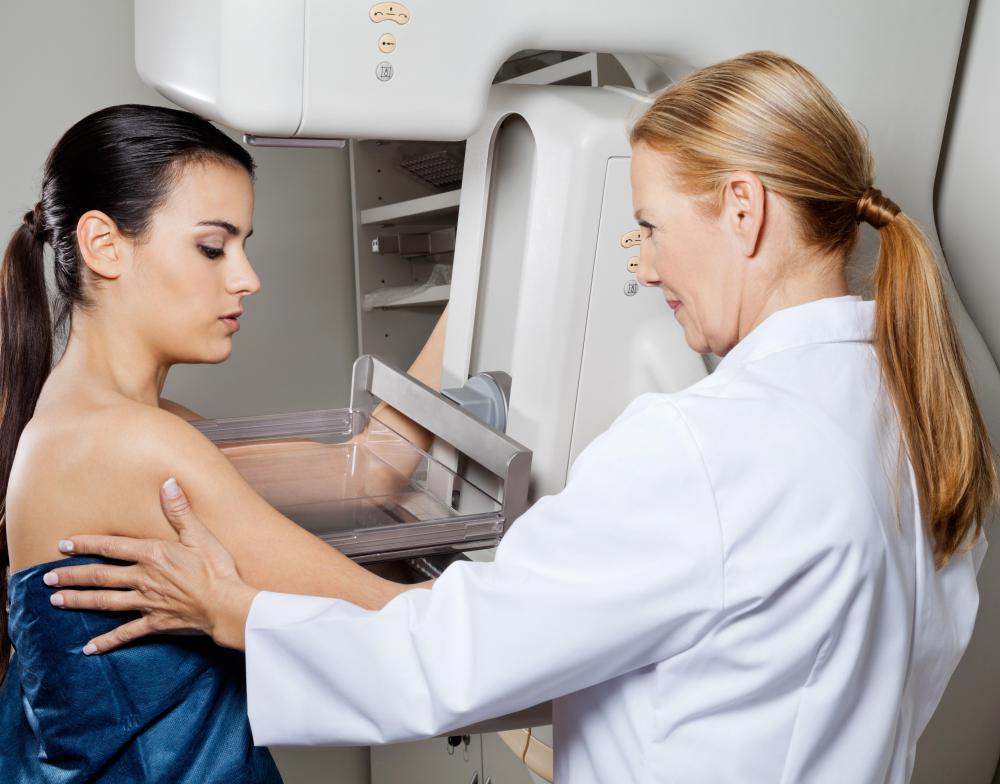At TheHealthBoard, we're committed to delivering accurate, trustworthy information. Our expert-authored content is rigorously fact-checked and sourced from credible authorities. Discover how we uphold the highest standards in providing you with reliable knowledge.
What Is the Breast Parenchyma?
In anatomical terms, the parenchyma of an body part refers to all the cells of that area that have an essential function. In the case of the breast parenchyma, these cells include the milk ducts and the glands that produce the milk. Apart from the parenchyma, fatty tissue is usually also present, the amount of which can vary with individual women. Certain diseases, such as breast cancer, can change the characteristics of the breast parenchyma.
Stroma is the scientific term for all of the tissue on the breast that is not part of the parenchyma. This is the fatty and connective tissue that gives the breast volume, and also provides an essential blood supply to the parenchymal cells of the breast. Each breast also has a system of ligaments that hold up the breast on the muscles of the chest. These are called "Cooper's ligaments," and are found throughout the breast, but end on the skin. This gives the breast its normal range of movement.

Much of the volume of the breast that is parenchymal tissue contains the lobules. These are the areas of the organs that produce milk for feeding a baby, and they are attached to ducts, which drain off the milk. Minor lactiferous ducts are small channels through which the milk flows into bigger major lactiferous ducts. From these major lactiferous ducts, the milk then travels into the major duct that is connected to the nipple. Babies receive their milk from the nipple, and the dark tissue around the nipple functions as a place for the child to latch on to.

All of the breast parenchyma, therefore, plays important roles in the function of the breast, whereas the stroma provides fat stores and supplies the blood supply to the breast cells. Even though blood is essential to the cells, this role is generalized to the rest of the body, and is not included in the parenchymal definition. Changes to the breast parenchyma, because of the important role it plays, can also signal onset of disease to doctors.

Medical technology has found that women have a normal range of density in their breast tissue. When the parenchymal tissues become altered, they can change in density, and this may be recognizable under imaging techniques such as a mammogram. Some cases of breast cancer are identifiable through alterations in parenchymal density, which may be beneficial to the treatment of patients.
AS FEATURED ON:
AS FEATURED ON:















Discussion Comments
@alisha-- @fify is absolutely right. Doctors have not found a link between a dense breast parenchyma and cancer. It is believed to be normal and passed on genetically. More than 25% of women have dense breast parenchyma with no higher risk of developing breast cancer.
A more than usual density of breast parenchyma just means that mammograms might be a bit more difficult for doctors to interpret because the dense tissue sometimes looks like suspicious masses. But there is no reason to jump to negative conclusions about dense breast parenchyma.
@alisha-- I was in the exact situation two years ago. I also have dense breast parenchyma in my right breast and a small lump in my left breast which is thankfully benign.
I don't think that a dense breast parenchyma means that you have cancer. The suspicious mass is different and only the biopsy can tell you whether it's benign or not. But do not jump to conclusions. I had the same worries when I found out about this but my biopsy came out clean. I still go for checkups every 6 months to see how the lump is doing.
I'm not sure why breast parenchyma becomes dense, but like I said, it doesn't mean that you have cancer. Just wait for the biopsy results.
Is there any study that has found a direct link between a dense breast parenchyma and cancer? What are the chances that a dense parenchyma is caused by cancer?
I had a mammogram and MRI last month and the result of my MRI mentions "dense breast parenchyma" along with asymmetry and a suspicious mass in one of my breasts. I'm scheduled to have a biopsy next week to see what the mass is. I don't really understand the technical report but it's going to be several weeks until I get the results of my biopsy.
What are the chances that this is cancer? Has anyone been diagnosed with a dense breast parenchyma before? What is your experience?
I'm really worried and would love to hear any advice on this subject.
Post your comments